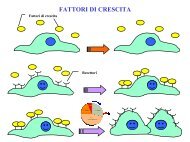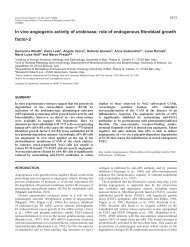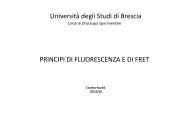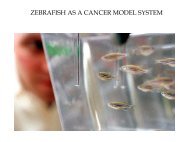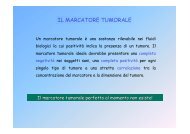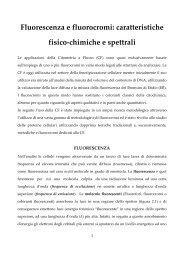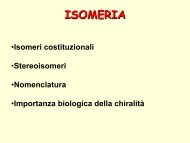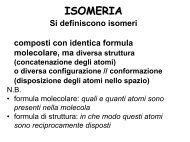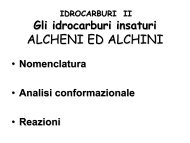Biological activity of substrate-bound basic fibroblast growth factor ...
Biological activity of substrate-bound basic fibroblast growth factor ...
Biological activity of substrate-bound basic fibroblast growth factor ...
You also want an ePaper? Increase the reach of your titles
YUMPU automatically turns print PDFs into web optimized ePapers that Google loves.
3896<br />
Materials and methods<br />
<strong>Biological</strong> <strong>activity</strong> <strong>of</strong> immobilized FGF2<br />
E Tanghetti et al<br />
Materials<br />
Human recombinant FGF2 was expressed and puri®ed from<br />
transformed E. coli cells as described (Isacchi et al., 1991).<br />
Anti-a v b 3 monoclonal LM 609 antibody was from Chemicon<br />
International (Temecula, CA, USA). For Western blotting,<br />
monoclonal anti-FGFR1 antibody and polyclonal antipp60<br />
src antibody were from Upstate Biotechnology (Lake<br />
Placid, NY, USA) and Santa Cruz Biotechnology (Santa<br />
Cruz, CA, USA), respectively. PD 098059 and SB 210313<br />
were from Calbiochem (San Diego, CA, USA) and RBI<br />
(Natick, MA, USA), respectively. PLL, tyrphostin 23,<br />
tyrphostin 63, rodaminate-phalloidin, and anti-vinculin antibody<br />
were from Sigma (St. Louis, MO, USA). Monoclonal<br />
anti-FAK antibody was a gift from G Tarone (University <strong>of</strong><br />
Turin, Italy). Bovine FN was from Harbor Bio-Products<br />
(Norwood, MA, USA) and human VN was from Becton<br />
Dickinson Labware (Bedford, MA, USA).<br />
Cell cultures and transfection<br />
Fetal bovine aortic endothelial GM 7373 cells, corresponding<br />
to the BFA-1c multilayered transformed clone (Grinspan et<br />
al., 1983), were grown in Eagle's minimal essential medium<br />
(MEM) containing 10% FCS, vitamins, essential and non<br />
essential amino acids.<br />
Plasmids 91023b-¯g (murine IIIc variant <strong>of</strong> FGFR-1<br />
cDNA), pCEP4-¯g 1.2 (truncated murine IIIc variant <strong>of</strong><br />
FGFR-1 cDNA) and pCB7 (a plasmid that carries the neo r<br />
gene) were provided by A Mansukhani and C Basilico (New<br />
York University Medical Center, New York, NY, USA).<br />
GM7373 cells were transfected with 91023b-¯g in association<br />
(10 : 1, wt:wt) with pCB7 according to a calcium phosphate<br />
precipitation protocol as described (Rusnati et al., 1996) and<br />
selected with 250 mg/ml <strong>of</strong> G418 (Sigma, St. Louis, MO,<br />
USA). Parallel cultures were transfected with pCEP4-¯g 1.2<br />
and selected with 200 mg/ml <strong>of</strong> hygromycin B (Boehringer<br />
Mannheim GmbH, Mannheim). For each transfection,<br />
resistant clones were tested for 125 I-FGF2 binding capacity<br />
(Rusnati et al., 1996) and by Western blotting using anti-<br />
FGFR1 antibody (Upstate Biotechnology, Lake Placid, NY,<br />
USA).<br />
Cell adhesion assay<br />
One hundred ml aliquots <strong>of</strong> 100 mM NaHCO 3 , pH 9.6<br />
(carbonate bu€er), containing the adhesive molecule under<br />
test were added to polystyrene non-tissue culture microtiter<br />
plates. After 16 h <strong>of</strong> incubation at 48C the solution was<br />
removed and wells were washed three times with cold<br />
phosphate bu€ered saline (PBS). Then, wells were incubated<br />
for 1 h at 378C with 1.0 mg/ml BSA and washed<br />
extensively with PBS. For the cell-adhesion assay, con¯uent<br />
cultures <strong>of</strong> GM 7373 cells were trypsinized, washed and<br />
resuspended with the appropriate medium. Previous observations<br />
had indicated that low concentrations <strong>of</strong> serum<br />
were required in some experiments for optimal cell<br />
adhesion to FGF2-coated plastic (Rusnati et al., 1997).<br />
For this reason, 1% FCS was utilized routinely in celladhesion<br />
experiments. Fifty thousand GM 7373 cells were<br />
resuspended in 200 ml <strong>of</strong> medium and were immediately<br />
seeded onto wells coated with the molecule under test.<br />
Routinely, cell-adhesion was allowed to occur for 2 h at<br />
378C. Then, wells were washed with 2 mM EDTA/PBS.<br />
Adherent cells were trypsinized and counted.<br />
Western blot analysis <strong>of</strong> cell-substratum contact sites<br />
Cells were seeded at 75 000 cells/cm 2 on plastic coated with<br />
the di€erent substrata. After 6 h, cells were detached from<br />
the plastic with 3 mM EDTA/PBS (Del Rosso et al., 1992).<br />
The material remaining on the plastic, representing plasma<br />
membrane remnants, was washed three times with PBS and<br />
extracted with 0.1 M Tris-HCl (pH 8.1) containing 1 mM<br />
PMSF, 0.2% sodium-deoxycholate, 1% Triton-X100. Aliquots<br />
(30 mg) <strong>of</strong> the extracted material were analysed by<br />
Western blotting with the indicated antibodies.<br />
Evaluation <strong>of</strong> the mitogenic <strong>activity</strong> <strong>of</strong> immobilized FGF2<br />
Parental and transfected GM7373 cells were seeded at<br />
130 000 cells/cm 2 onto 96-well plates coated with the di€erent<br />
substrata and incubated for 2 h at 378C with MEM<br />
containing 1% FCS. Then, cells were washed with 2 mM<br />
EDTA/PBS (T 0 ). Adherent cells were incubated for further<br />
24, 48 or 72 h in fresh MEM containing 0.4% FCS. In some<br />
experiments, medium was added with di€erent inhibitors. At<br />
the end <strong>of</strong> incubation, cells were trypsinized and counted in a<br />
Burker chamber. Data are expressed as cell population<br />
doublings in respect to cells adherent at T 0 .<br />
Western blot analysis <strong>of</strong> ERK 1/2 phosphorylation<br />
Parental and transfected GM7373 cells were seeded at 42 000<br />
cells/cm 2 in 35 mm tissue culture dishes. After adhesion, cells<br />
were incubated in serum-free MEM added with 10 mg/ml<br />
transferrin and 1 mg/ml BSA. After 24 h, cells were<br />
incubated for 20 min at 378C with no addition or 2.0 or<br />
10.0 ng/ml FGF2. Then, Western blot analysis <strong>of</strong> the cell<br />
extracts was performed as described (Besser et al., 1995)<br />
using anti-phospho-ERK 1/2 antibody (New England Biolabs,<br />
Inc., Beverly, MA, USA).<br />
In some experiments, GM7373 cells were seeded at 90 000<br />
cells/cm 2 in 35 mm dishes coated with FGF2 or FN in the<br />
absence or in the presence <strong>of</strong> 50 mM PD 098059 or SB<br />
210313. After 1 or 2 h, cell extracts were analysed for ERK 1/2<br />
phosphorylation as above.<br />
For all the experiments, equal loading <strong>of</strong> the di€erent lanes<br />
<strong>of</strong> the gel were con®rmed by Western blotting <strong>of</strong> the stripped<br />
membranes with anti-ERK 1/2 antibody (not shown).<br />
Immunocytochemistry<br />
Cells were seeded onto FGF2- or FN-coated glass coverslips<br />
in MEM added with 1% FCS. After 2 ± 6 h, cells were<br />
washed, ®xed in 3% paraformaldehyde, 2% sucrose in PBS,<br />
permeabilized with 0.5% Triton-X100, and saturated with<br />
3% BSA in PBS. Then, in a ®rst set <strong>of</strong> experiments, cells<br />
were incubated with monoclonal anti-vinculin antibody<br />
followed by ¯uorescinated anti-mouse IgG plus rodaminatephalloidin.<br />
In a second set <strong>of</strong> experiments, cells were<br />
incubated with monoclonal anti-paxillin antibody (Transduction<br />
Laboratories, Lexington, KY, USA) followed by Alexa<br />
Fluor 594 anti-mouse IgG (Molecular Probes, Eugene, OR,<br />
USA) and polyclonal anti-FGFR1 antibody (Santa Cruz<br />
Biotechnology) followed by biotinylated swine anti-rabbit<br />
IgG (Dako, Glostrup, Denmark) and rhodol green conjugated<br />
streptavidin (Molecular Probes).<br />
Scanning electron microscopy<br />
Glass coverslips (10 mm in diameter) were placed within<br />
24-well tissue culture plates and coated overnight at 48C<br />
Oncogene



